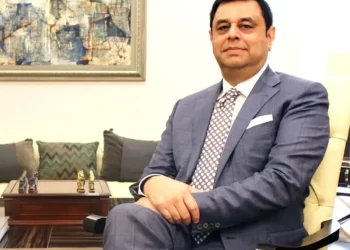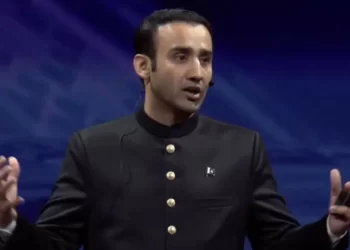Two astronauts from a SpaceX capsule in Earth’s orbit carried out the world’s first private spacewalk on Thursday, tethered to the Crew Dragon spacecraft in the vacuum of space while two others watched from inside, hundreds of miles from Earth.
Billionaire Jared Isaacman, 41, exited first about 6:52 a.m. ET (1052 GMT), followed by SpaceX engineer Sarah Gillis, 30, becoming the first two non-government individuals to conduct such an excursion in space. All their maneuvers streamed live on the company’s website.
The mission appeared to successfully test trailblazing equipment, including slim spacesuits and a process to fully depressurize the Crew Dragon cabin – technology that could be used in future private space missions.
It was one of the riskiest treks yet for Elon Musk’s space company, the only private firm capable of routinely sending humans to and from Earth’s orbit.
“Back at home we all have a lot of work to do, but from here, Earth sure looks like a perfect world,” Isaacman said after emerging from the spacecraft, silhouetted with the half-lit planet glittering 700 km (434.9 miles) below him.
Before the spacewalk began, the capsule was completely depressurized, with the whole crew relying on their slim, SpaceX-developed spacesuits for oxygen, provided via an umbilical connection to Crew Dragon.
The spacewalk was scheduled to last only about 30 minutes, but the procedures to prepare for it and to finish it safely lasted an hour and 46 minutes. It marked a risky test of the new spacesuit designs and procedures for the capsule, among other things, in a mission meant to push the boundaries of what private companies can do in Earth’s orbit.
As the two astronauts returned to their cabin seats, SpaceX ground teams at the company’s Hawthorne, California, headquarters watched as the capsule’s hatch door sealed shut and carried out leak checks. The spacewalk officially ended around 8 a.m. ET.
Isaacman, Gillis, Scott Poteet, 50, a retired U.S. Air Force lieutenant colonel, and SpaceX engineer Anna Menon, 38, had been orbiting Earth aboard Crew Dragon since Tuesday’s pre-dawn launch from Florida of the Polaris Dawn mission. Menon and Poteet remained inside the spacecraft during the spacewalk.
It is the Elon Musk-led company’s latest and riskiest bid to push the boundaries of commercial spaceflight.
Isaacman, a pilot and the billionaire founder of electronic payments company Shift4, is bankrolling the Polaris mission, as he did his Inspiration4 flight with SpaceX in 2021.
He has declined to say how much he is paying, but the missions are likely to cost hundreds of millions of dollars, based on Crew Dragon’s price of roughly $55 million a seat for other flights.
NASA administrator Bill Nelson praised the spacewalk. The agency helped fund Crew Dragon development beginning roughly a decade ago.
“Today’s success represents a giant leap forward for the commercial space industry and @NASA’s long-term goal to build a vibrant U.S. space economy,” Nelson wrote on X.
FARTHEST SINCE APOLLO
Throughout Wednesday, the craft circled Earth at least six times in an oval orbit as shallow as 190 km (118 miles) and stretching out as far as 1,400 km (870 miles), the farthest in space that humans have traveled since the last U.S. Apollo mission in 1972.
The gumdrop-shaped spacecraft then began to lower its orbit into a peak 700-km (435-mile) position and adjust cabin pressure to ready for the spacewalk, formally called Extravehicular Activity (EVA), the Polaris program said on Wednesday.
“The crew also spent a few hours demonstrating the suit’s pressurized mobility, verifying positions and accessibility in microgravity along with preparing the cabin for the EVA,” it said.
Only government astronauts with several years of training have done spacewalks in the past.









